Best practices for structuring and optimising your content
Discover the best practices for structuring and optimising your content
Content management, a technical issue or a strategic approach?
Apart from the question of budget, we often try to brandish the sword of technical choice by imagining that the tool will be the most complex to choose, implement, use...
However, setting up a new content management tool is not so much a technical problem as a human adventure.
Indeed, our customer experience and our exchanges with our partners lead us to affirm that it is the users and managers who must be addressed because, as we shall see, through the integration of a new content management tool, it is the entire organisation that must be prepared to accept this change.
Today, all companies are faced with the same fundamental question: how to quickly process and relay the right information, at the right time and on the right channel, to the right person.
However, the volume of information to be processed is exponential and the distribution channels are multiplying rapidly. Managing all this information, whether structured or not, can quickly become complex and time-consuming and become a brake on efficiency and productivity.
The implementation of content management tools thus responds to many strategic challenges for companies.
Implementing a new tool: Choosing
a new organisational data management policy
Setting the strategic framework for the organisation's new content management policy
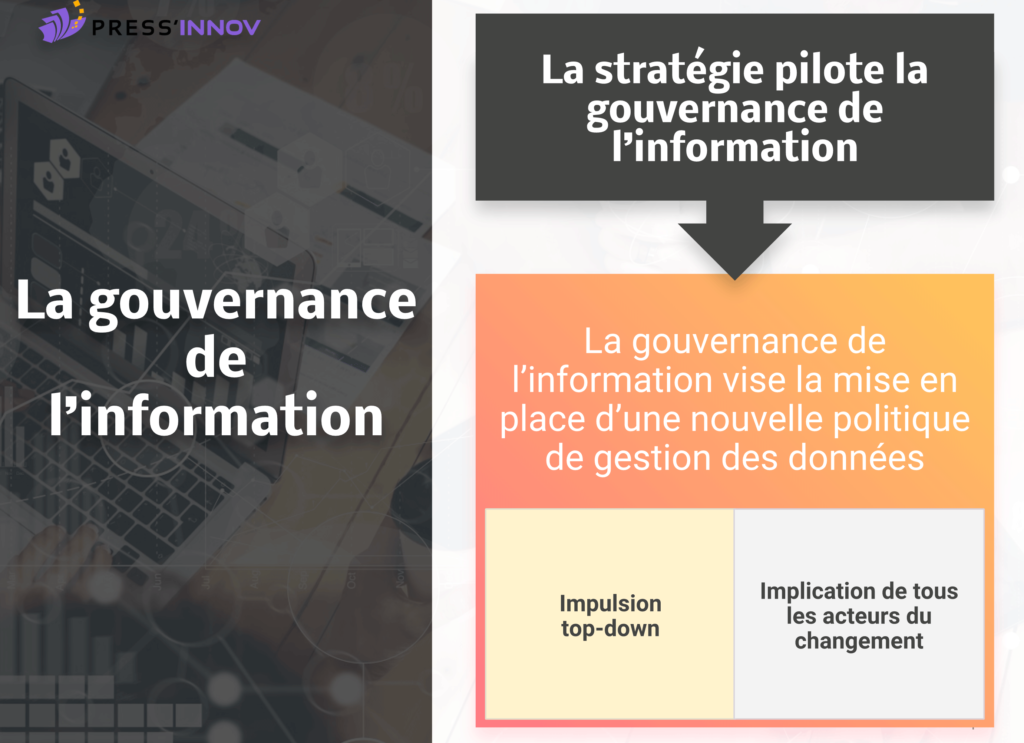
We will not deal with the issue of personal data management here, as the so-called RGPD is currently the subject of much expert discussion.
For the part that concerns us, it is a question of establishing the strategic framework of this policy: information governance. It is the decision-makers who must give the impetus, provide the vision and communicate on this new vision: What are the objectives?
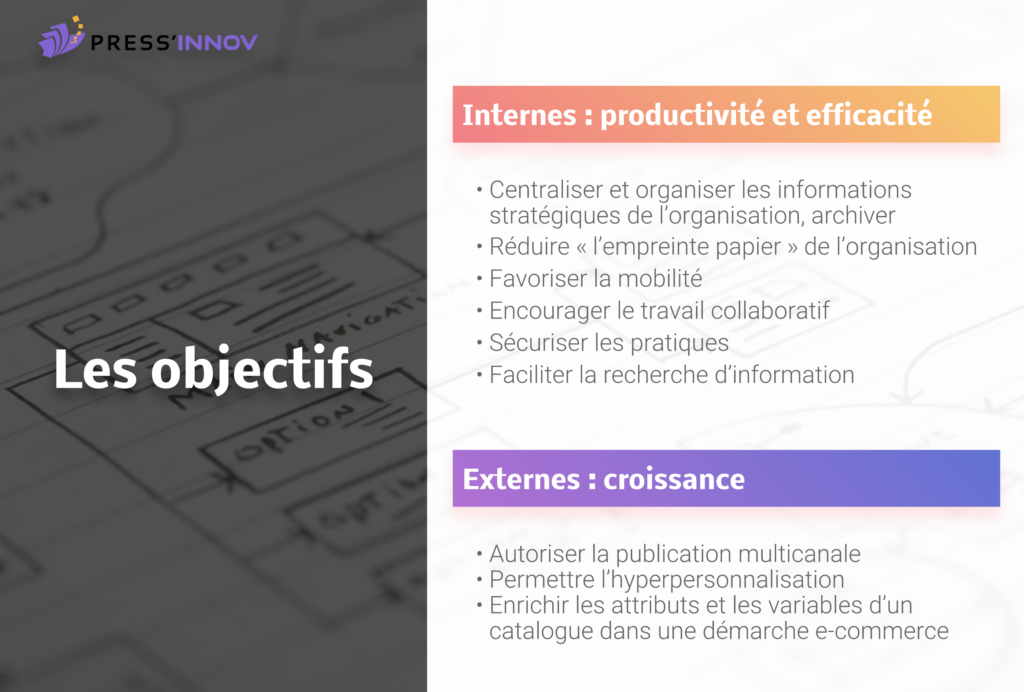
Projecting into the future of the organisation and defining the target system
Once the decision has been taken and the framework has been established (project organisation, methodology, etc.), the existing processes must first be reviewed, and what is to be kept, what is to be eliminated and what is to be changed.
In practice, the focus is of course on working hand in hand with the project managers. But this is not enough. We then set up business workshops to define a mapping of the organisation and processes that is as precise as possible, allowing us to visualise in a concrete way how the information is structured (or not) and what the target system is. The phase of collecting requirements and projecting the organisation into the future is an essential phase.
Structuring content: asking the right questions

Volumetry :
The structuring and processing of information varies according to the volume of content: in the case of small quantities, categorisation and metadata will be processed differently than in the case of large volumes, for which keyword processing or machine learning categorisation tools can help to better understand these large volumes.
Lifetime :
The management of the information life cycle will have to be defined: what content is affected by obsolescence and when? Is it recurrent? How should updates be managed? What actions will have to be taken, and within what timeframe? What information is the most important, the most useful? What information should be consulted and retrieved as easily and as quickly as possible?
Granularity :
Finally, the granularity of your stored information is important depending on the target products that will be used by the end user. What level of structure for which document units?
Choosing the right management tool
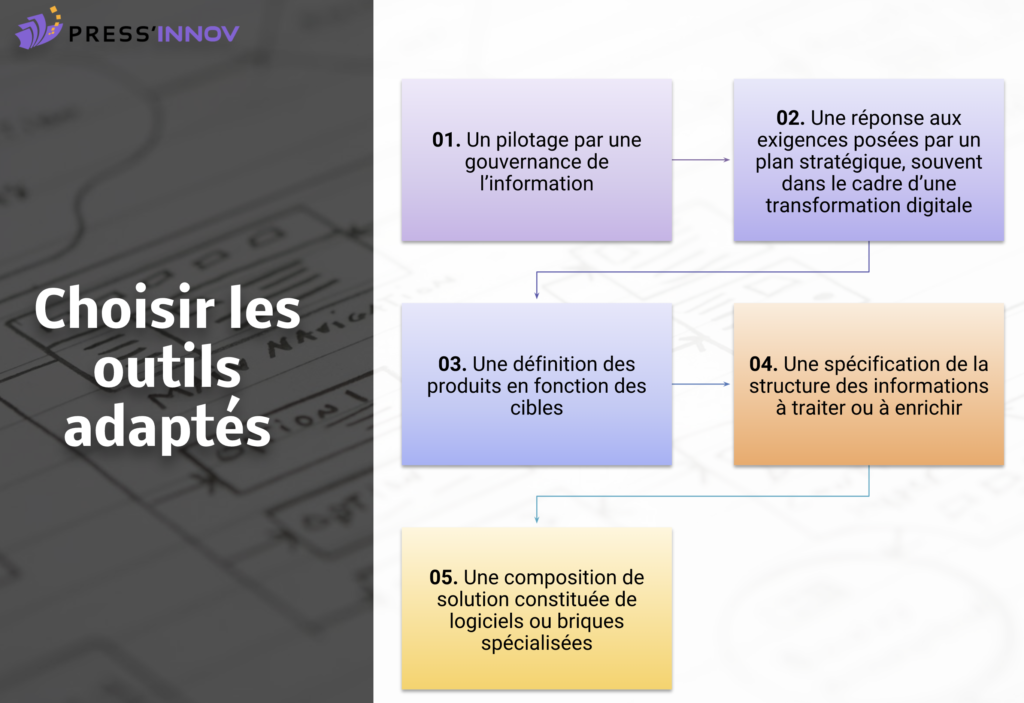
Respect the 4 preliminary phases:
- The framework is set and management has communicated its vision
- Objectives set and prioritised
- The products are defined
- The scope of the content and its structure are specified
It's time to choose a tool
From ECM to big content
In a hyper-connected ecosystem, the centralisation of content and the streamlining of processes are pushing organisations towards contextualisation and hyper-personalisation: it is a question of giving oneself the means to analyse and exploit the organisation's mass of data, what it produces, what it collects, incoming and outgoing data: Email, scans, office documents, system files, etc.
The natural evolution of the tools, dictated by a customer logic and the brand strategy, naturally leads us to a system that takes the whole organisation with it
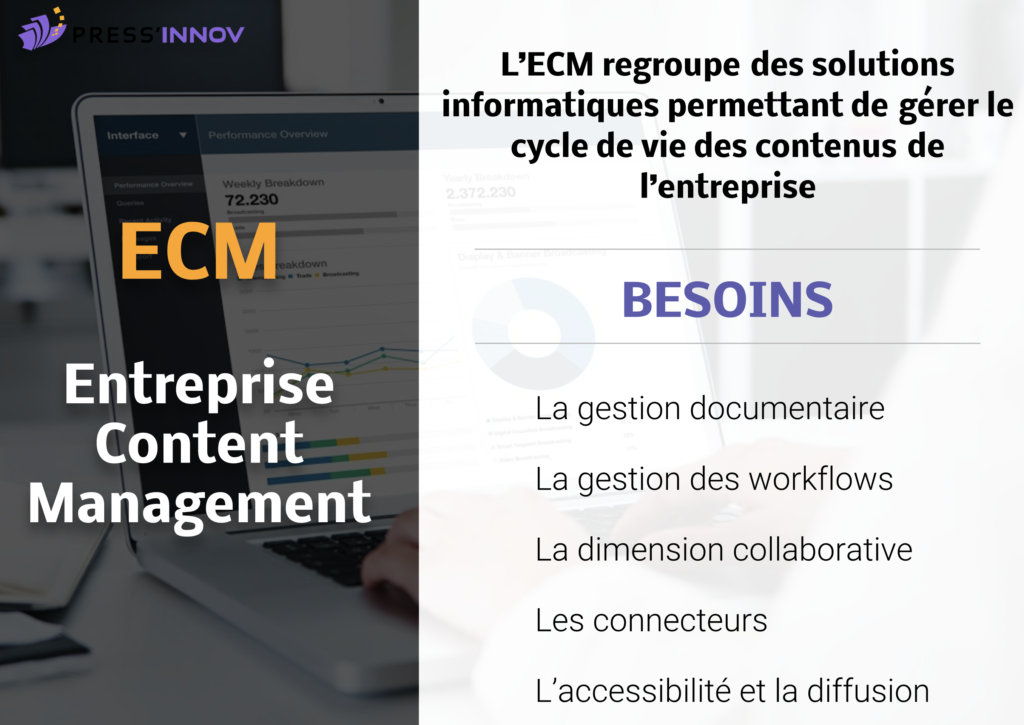
Covering the needs of the dematerialisation process
Typology of content management tools: Overview
ECM extends the scope of the EDM to all enterprise content, both structured and unstructured, including web content (WCM), and content managed by other applications in the organisation.
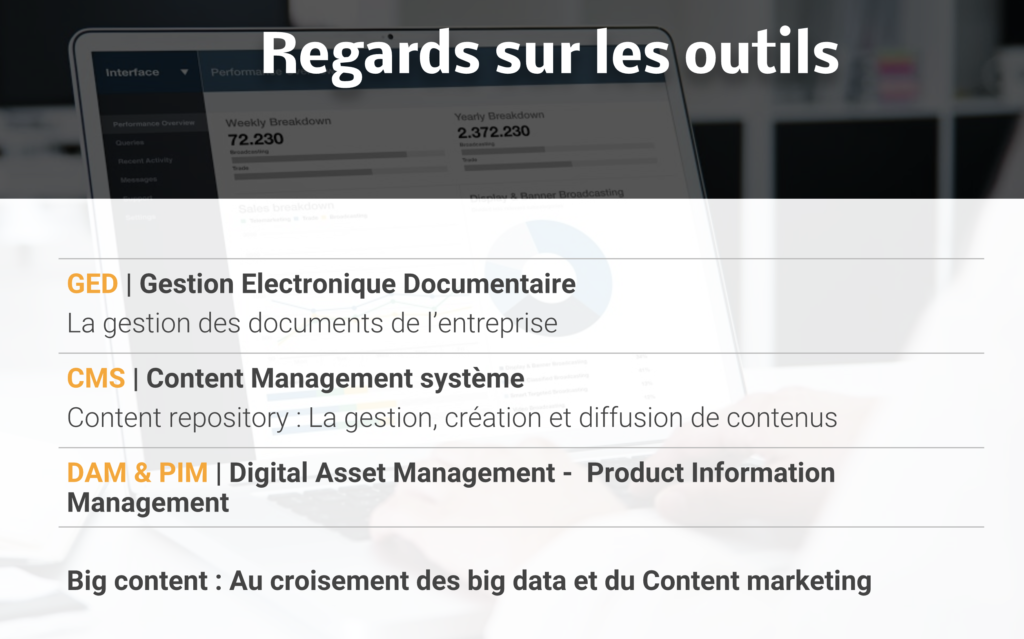
- Electronic Document Management - EDM
EDM is concerned with the company's documents. Oriented towards file management, EDM solutions have evolved to integrate an increasingly wide range of document types (e-mail, forms, high-value technical documents or simply administrative documents, images, videos, etc.).
- Content Management System - CMS
A CMS manages content that is not necessarily materialized in a file. They are entered into the tool, directly from its interface, then stored in a data repository. It is therefore the "content repository" that is at the heart of CMS tools.
Today, CMSs are essentially web publishing tools. They are sometimes called WCMS for Web Content Management System.
- Digital Asset Management - DAM
A DAM solution provides the company with a central interface and a single repository to facilitate and accelerate the management of all the brand's digital assets, including images (photos, videos, illustrations, audio). The term MAM or Marketing Asset Management is also used when integrating all graphic creation or transformation files, presentations and other marketing documents.)
- Production Information Management - PIM
The PIM is the repository of product catalogue information. This platform enables the information to be aggregated and distributed. It also ensures its quality and possible enrichment.
- The big content
The natural evolution of the tools, guided by the customer logic and the brand's content strategies, naturally leads us to a system that goes beyond the initial issues of productivity, agility and mobility.
Each product has multiple attributes and variations. This information is essential to influence buyers. It is therefore critical to simplify the processing of this data in order to develop sales. A new vision of data management is emerging: "Big content".
Big content is the cross-fertilisation of big data and content marketing, and should enable specific targets to be reached with enriched content. This means that target audiences can be engaged with tremendous precision. It is therefore a real springboard for digital marketing and a definite challenge for all companies.
From content management to digital transformation:
The change process
We have seen, through this first approach, that the implementation of these tools cannot be undertaken lightly and that content management tools are often the cause of profound changes.
They need to be supported within the framework of a change management process in order to respond to 4 change issues:
- Growth and productivity issues
- HR issues
- Cultural issues
- Technical and functional issues
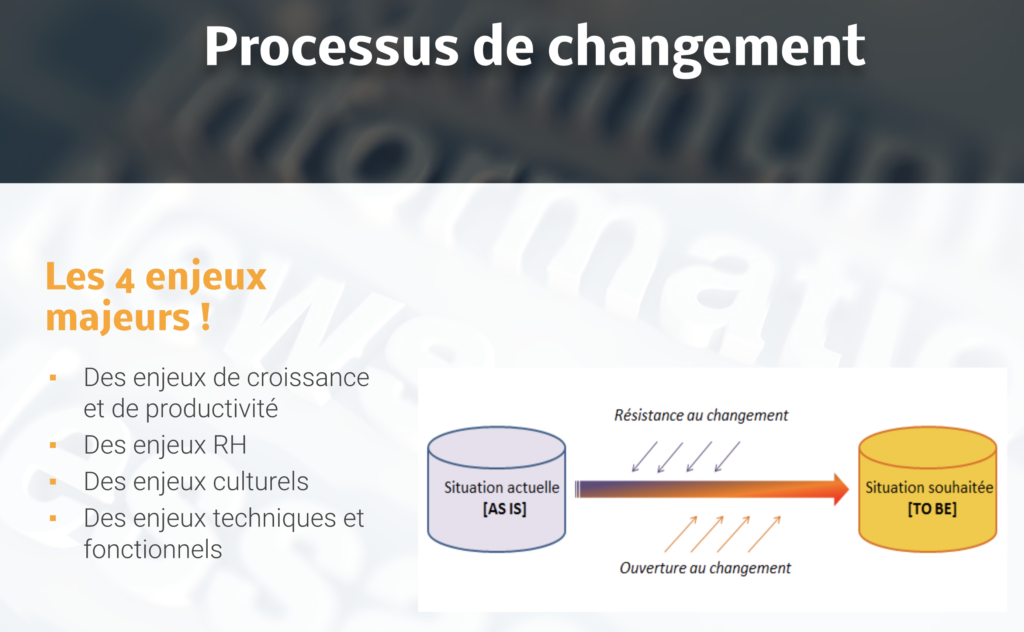
The process of change is translated into a diagram which indicates that the objective of the change trajectory is to go from an existing and current situation to a desired and projected situation which is the target system.
As we can see, this process is full of pitfalls because we will meet along the way, certainly those who drive the change and those who carry it out on a daily basis, but we will also meet conscious or unconscious obstacles, but we must be careful to avoid the risk of seeing the process slow down with heavy impacts on the organisation's project planning.
Why is there resistance to change? Because the organisation, caught up in the technical whirlwind of implementing the tool, tends to overlook the fact that it is people who use and enrich information systems, and that habits and skills must evolve to be aligned with a new system.
Not paying attention to resistance signals also means that you run the risk that the tool will not be used in the long run.
Identifying changes
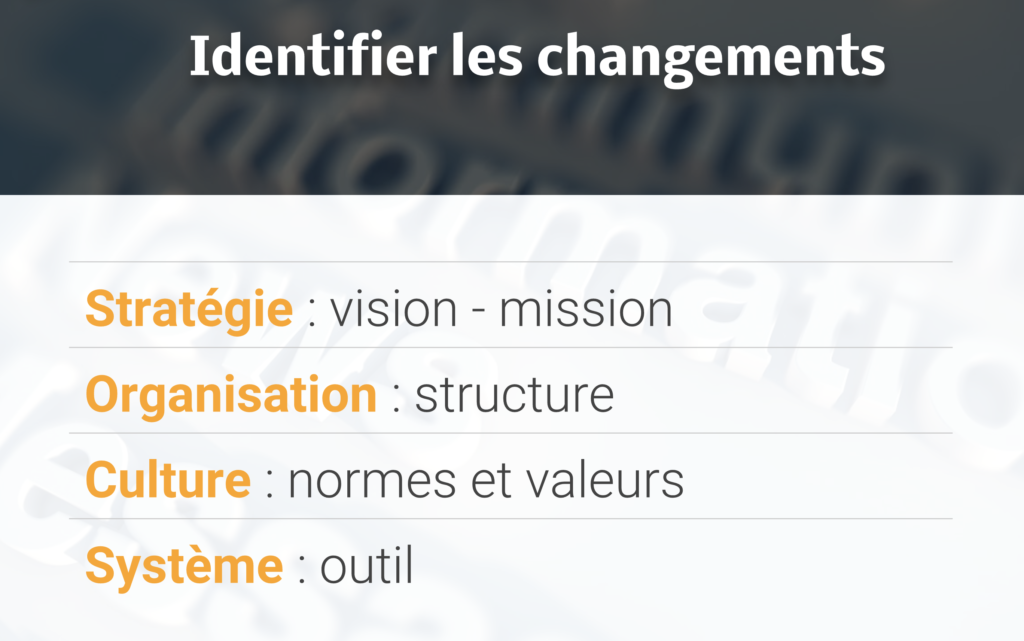
The scope of the changes brought about by the implementation of a new information management system goes far beyond what one might imagine:
Strategic change is about the direction an organisation is taking and mainly questions the missions of the employees, their added value, the "customer" journey.
Accompanying this change means transposing the objectives to a concrete work situation. For each person affected by a development or a change of mission, it will be necessary to explain how daily life will be modified.
Strategic change can have far-reaching consequences for management while only slightly altering the daily lives of employees. This is currently the view of strategic change initiated when communication is in its infancy and the system change has not yet taken place. This is thefirst change that employees are confronted with.
The change in direction that the organisation takes often involves structural change:
A structural change is a change in the structure of the organisation. Structural changes generally impact the organisation chart of the entity concerned. Often felt as a threat by employees, they are a source of uncertainty because they can impact on their responsibilities, such as the loss of a hierarchical level through the appointment of an intermediate layer or a change of workplace.
It is often in this case that middle management is caught in the middle: they are expected to explain the structural change to their staff and support it, but at the same time they have to deal with questions and resistance, and continue to run their department. They are also often at the centre of the change.
Cultural change is a change in the norms and values of the organisation, and therefore in the way people think and work. It is a collective learning process that takes time, as behaviours are very ingrained and employees often see them as 'normal' behaviours when in fact they are specific to the organisation.
Finally, a system change is a change in the work processes, rules and procedures that organise day-to-day operations. These changes often involve the acquisition of new skills.
Supporting change
The appropriate support can be determined after studying the various impacts directly or indirectly linked to the implementation of a new content management tool.
From our experience in the field, any support should have at least 3 components:
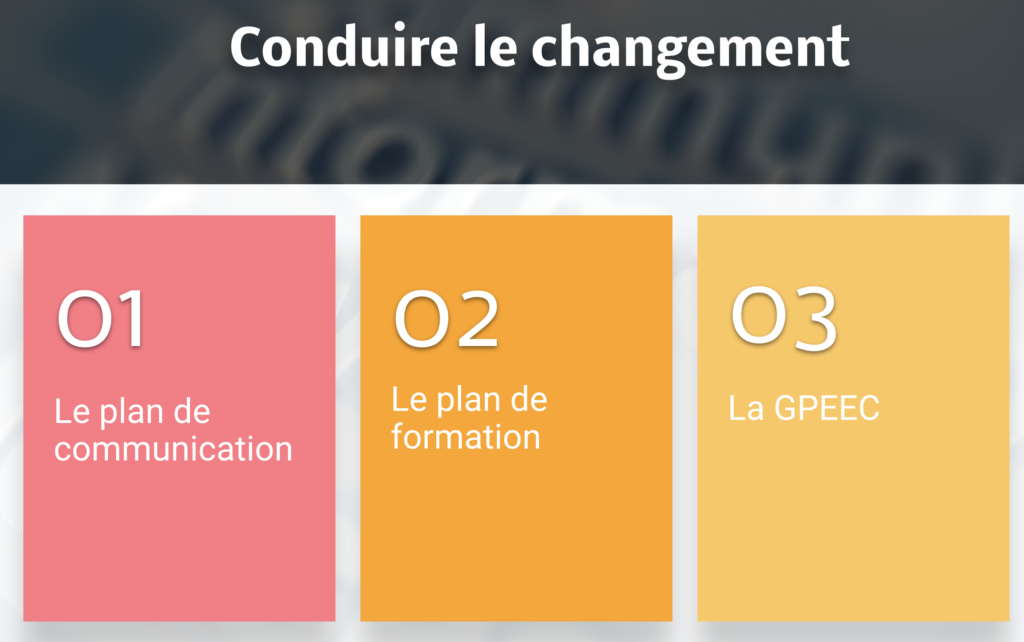
Communication, exchange and dialogue must be at the heart of any support for change
The aim here is to build a communication plan that integrates not only project communication but also communication in a context of change. The definition of target audiences and the choice of media, the construction of messages, all of which are aligned with the project schedule, will be decisive factors in your success.
In the same way as the communication plan, the training plan and all the measures to help employees get to grips with the tool are a major lever for change, transforming the company into a learning organisation.
The forward-looking management of jobs and skills, established with regard to your new data management and information governance policy and therefore perfectly framed, will provide you with the necessary insight for the acquisition of new talents and expertise.
Looking for your new experts? Welcome to ContentSide!
Documation - Best practices for structuring and optimising your content from ContentSide
Are you interested in this topic?